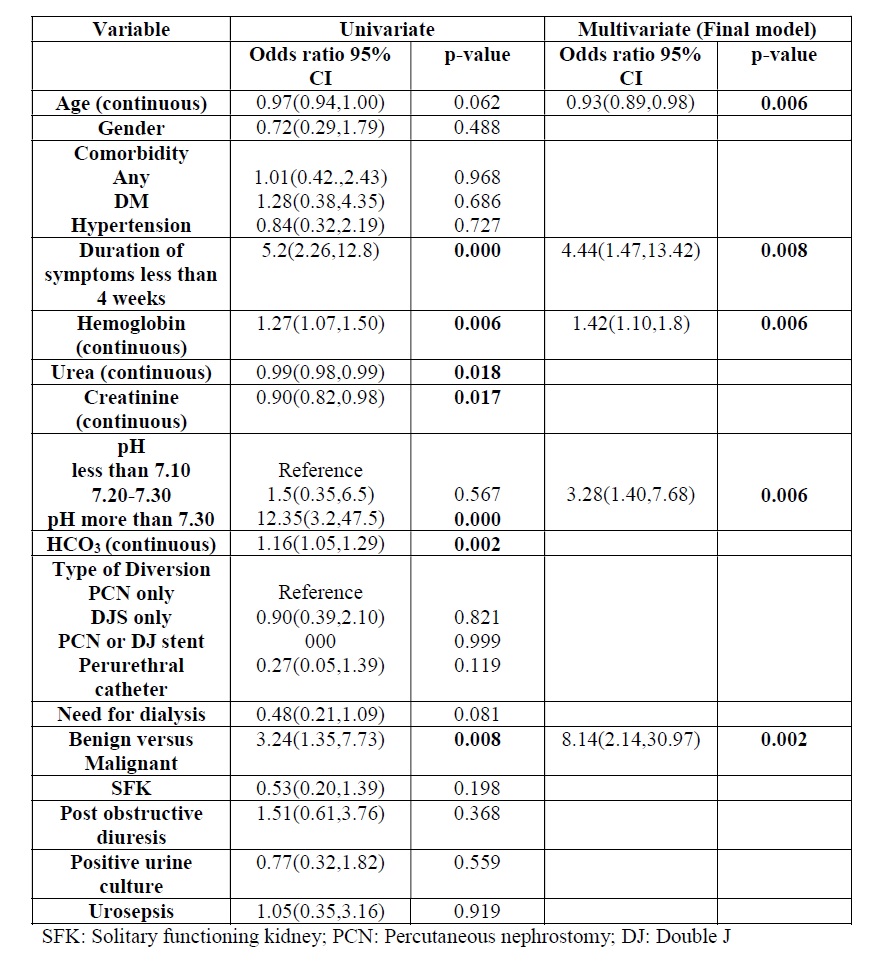Back
Poster, Podium & Video Sessions
Moderated Poster
MP19: Education Research II
MP19-18: Nomogram predicting renal function recovery post diversion in patients with obstructive uropathy
Saturday, May 14, 2022
7:00 AM – 8:15 AM
Location: Room 228
Gopal Sharma*, Sudheer K Devana, Ravimohan S Mavuduru, Kalpesh M Parmar, Chandigarh, India
- GS
Poster Presenter(s)
Introduction: Identifying the predictors of recovery of renal function following urinary diversion in patients with obstructive uropathy (OU) can be of great prognostic and clinical significance to a urologist. We aimed to develop a nomogram predicting recovery of renal function in patients with OU following urinary diversion.
Methods: In this prospective observational study, we included patients of OU (aged 18-65 years) presenting with raised serum creatinine (>2.0 mg/dl) due to various etiologies. Renal function recovery was defined as creatinine =1.5 at 4 weeks after diversion. Univariate and multivariate regression analysis was used to identify predictors of renal function recovery. Nomogram was developed using variables identified in multivariate analysis. Nomogram was internally validated with boot strapping, goodness of fit, calibration plot and receiver operating curve (ROC) analysis. Decision curve analysis (DCA) was used to determine clinical utility of the nomogram.
Results: Of 110 patients included in the study, 40 patients (36.4%) had renal function recovery after diversion. On multivariate analysis, age, etiology, duration of symptoms, baseline hemoglobin level and pH were identified as independent predictors of renal function recovery. Nomogram was developed using above mentioned variables, internally validated and had an area under curve of 0.89 for predicting renal recovery. Nomogram was found to be clinically useful at threshold probability of 5% renal recovery.
Conclusions: We developed and internally validated a nomogram which is highly accurate and simple to use in predicting renal function recovery after diversion in patients with OU. However, it needs external validation before widespread use.
Source of Funding: None



Methods: In this prospective observational study, we included patients of OU (aged 18-65 years) presenting with raised serum creatinine (>2.0 mg/dl) due to various etiologies. Renal function recovery was defined as creatinine =1.5 at 4 weeks after diversion. Univariate and multivariate regression analysis was used to identify predictors of renal function recovery. Nomogram was developed using variables identified in multivariate analysis. Nomogram was internally validated with boot strapping, goodness of fit, calibration plot and receiver operating curve (ROC) analysis. Decision curve analysis (DCA) was used to determine clinical utility of the nomogram.
Results: Of 110 patients included in the study, 40 patients (36.4%) had renal function recovery after diversion. On multivariate analysis, age, etiology, duration of symptoms, baseline hemoglobin level and pH were identified as independent predictors of renal function recovery. Nomogram was developed using above mentioned variables, internally validated and had an area under curve of 0.89 for predicting renal recovery. Nomogram was found to be clinically useful at threshold probability of 5% renal recovery.
Conclusions: We developed and internally validated a nomogram which is highly accurate and simple to use in predicting renal function recovery after diversion in patients with OU. However, it needs external validation before widespread use.
Source of Funding: None




.jpg)
.jpg)